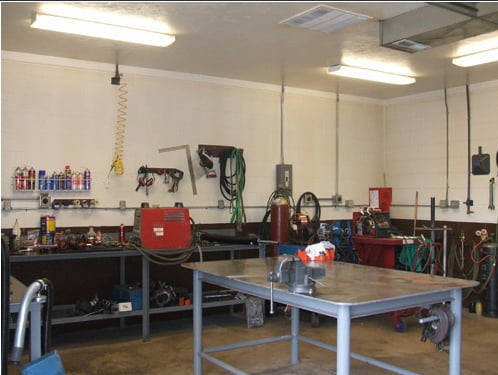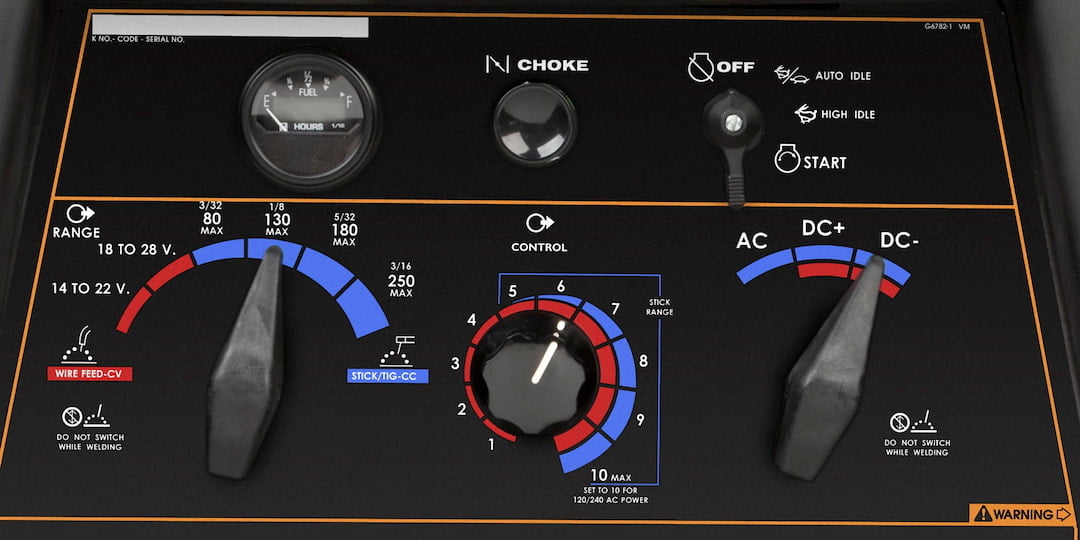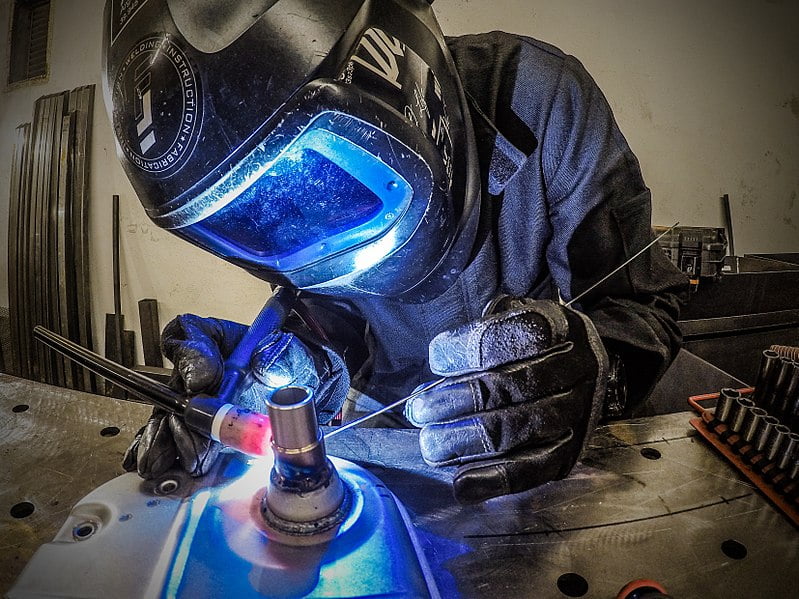Colleagues have been recommending the TIG method, but you haven’t used it before. That’s what led you to seek a guidebook on TIG welding for beginners.
Table of Contents
Key Takeaways
- TIG welder doesn't use a wire running through your machine; you use your torch to strike the arc and provide heat, and you use TIG welding rods to make the welds
- The most common type of welding gas in TIG welding is 100% argon. You can also use a 75 to 25 percent combination of argon and helium
- TIG welders can be used to weld steel, stainless steel, chromoly, aluminum, nickel alloys, magnesium, copper, brass, bronze, and even gold
- You must have a very clean base metal to achieve an effective weld
- Learn which electrode works best in which welding conditions
You’ve been welding for a little bit of time, and have mastered some of the tig welding basics. You would like to get the best TIG welder there is because MIG is sometimes not quite the right option for your project as we explained in our MIG vs TIG article. Arc welding type varies based on the welding materials and welding work conditions.
We’ve got basic TIG welding facts so you can learn the process. We answer everything from what is TIG welding to how to TIG weld. The article will cover TIG welding tips for gas, arcs, filler rod, and techniques like tig welding aluminum. By the end, you will be familiarized with the basic TIG welding techniques and ready to jump right in and get started on your first TIG welding project!
TIG Welding for Beginners – Must Know TIG Welding Tips & Facts
What is Tungsten Inert Gas (TIG) welding? This method of welding offers more flexibility than other methods, and it’s also more versatile. This makes it one of the harder methods to master, and you need some extra practice, but it’s well worth it. If you want to be a successful TIG welder, you need to have patience and the desire to learn. TIG welding basics, tips and the right TIG welding machines are all you need as long as you also get familiar with stainless steel, aluminum and other base materials which are frequently welded.
TIG, also called GTAW (Gas Tungsten Arc Welding), uses a welder but instead of a wire running through your machine, you used your torch to strike the arc and provide heat and you use TIG welding rods to make the welds.
There are several tricks you can use to control your puddle while TIG welding. This method also enables a consistent TIG welder arc that will ensure solid welds no matter what your project and what material thickness. Here are some TIG welding tips and tricks to help you start welding in no time!
Learn to TIG Weld
When you’re learning how to weld using this process, it is important to know your shielding gases. The most common type of welding gas in TIG welding is 100% argon. You can also use a 75 to 25 percent combination of argon and helium as a shielding gas. Increasing the helium content will decrease your temperatures. This can cause issues with striking your arc. Set your shielding gas to 15 to 20 cubic feet per hour as a beginner. Higher settings will blow out your weld.
How a TIG Welder Works and When to TIG Weld
Now that we’ve gone over some of the TIG welding tips and basics, let’s answer the next big question: what is TIG welding used for?
This process can be used to join nearly any metal with superior quality. It is the method that has the fewest defects when done properly. It's also good for easier cleanup because there is no spatter in this process. It's also got the most penetration of any welding technique.
TIG welding equipment includes a TIG welder, an electric torch and hand-fed filler rod which melt into the weld puddle. The thing that differentiates TIG welding from other methods is that you can soft start and stop the heat at any point in the process. This gives you precise control over your work.
Getting Started with TIG Welding Process
When you start the process of learning how to weld, you want to begin by setting up your TIG welder and starting the arc on the stainless steel or other material. Get a feel for how the welding arc and puddle work. Then, you can try welding on some sheet metal surface without rods. This allows you to learn how the weld puddle moves and get practice maintaining your arc length. Then, add filler and familiarize yourself with welding aluminum, stainless steel or other base materials.
TIG Welder Torch Angle and Movement
Your welder torch angle is not the same as your rod angle. If you keep the angle the same on both of these, you will cause the heat to bounce around while you work. This will result in your rod melting before you want it to, creating inferior beading. You always want to be the one feeding the rod into your welding pool.
The TIG welding torch movement should be steady and stop only briefly when adding filler material. Hold the torch at about 20 degrees from a vertical position. Tilt it so that the tungsten will point towards your weld. This allows the weld pool to form ahead of your torch, which will make it easier to add filler rods later.
The gap between your work and the tungsten should be between 1 and 1.5 times the diameter of your tungsten. Move your TIG torch across the work as a dry run before you begin your weld so you can practice your torch angle and distance. This will help you naturally maintain it and prevent you from problems along the way.
TIG Welding Arc Length
TIG welders want to reduce the arc slowly instead of abruptly ending it. Keep the foot pedal (or other mechanisms for temperature control) around ¾ of the way down when you weld at temperature. Keep in mind that the propper control of the foot pedal allows your arc to trail off when you hit the end of your weld. If you end abruptly, it will cause your weld to crack.
Feeding TIG Rods
You want to use bigger rods when possible. Larger rods are easier to feed into your TIG welder. Standard TIG welder filler rods are usually 3/32 or lower in diameter. If you choose a 1/8-inch diameter rod when possible, it will make it easier for you to learn how to feed your filler rods through and make your TIG welding processes easier.
Wear the Proper Welding Safety Equipment
A lot of novice welders don’t know how critical proper safety gear is. You should always wear your best welding helmet, welding gloves and a leather apron. This applies to anything related to the TIG or MIG welding task at hand.
The thoriated Tungsten electrodes contain 2% Thorium which is radioactive. This means that a welder must wear a respirator when you are grinding them to make a tip. The respirator will protect your air passageways and keep you safe so you can focus on welding processes at hand.

For the sake of welding safety, you also want to have a workspace that is free of any dust and make sure that there is adequate ventilation in your shop.
When using TIG welders, you also want to have something around that will protect you from being shocked. The easiest way to do this is by having something on your welding table that is non-conductive.
Gloves and a welding apron are a great way to protect your arms. Wood is another good option to keep around when TIG welding.
Have Filler Metal Charts Available
Having these charts in your shop can help you select the right rods for your job. This will ensure that you know what to use no matter what material or welding machines you are working with on a given day.
TIG 101 - GTAW Welding Facts and Advice Video Tutorial
Tips to Improve Your TIG Welds
Let's look at some of the more advanced TIG welding tips for successful welds! Make sure to master TIG machines settings and features.
Using Minimum Power
This trick is especially true for novice welders. When you start practicing, use the minimum power available in the settings that will still result in a sustainable puddle.
TIG welding is fully based on penetration. Too much of it, and you will burn through your base material. Too little gives weak welds.
This method requires finesse when it comes to power levels. These become almost more important than your welding technique itself!

Find a Steady Position While Working
Important part of the GTAW welding process is being able to control the distance between the work and the tungsten to within 1 mm of space. This level of control is only possible when you have a stable welding position.
As with other types of welding, sit on a workbench if possible. This will help with the position, but the bench should not be supporting upper body weight. Hold your welding torch in your dominant hand. Rest your hand lightly on the bench or a piece of wood for a correct angle and to prevent shocking.
Wrap the torch lead around your arm to take the weight away from the torch and prevent snagging during welding. Position the head to the side for a good view of your weld pool. Beginners frequently make the mistake of hiding the weld behind their gas shroud.
Lighting should come from the side and overhead so you can see your electrode position before beginning to weld. Move the torch away in a pulling manner. Relax your muscles to help control the torch better. Your eyes should be relatively close to the weld puddle so you can see what you're doing but not too close to breathe in the fumes.

Keep Your Metals Clean
In any welding, it is always a good idea to prepare and clean your metals before you begin.
This is especially true of TIG welding, which does not have as much forgiveness as other methods when it comes to contamination. You must have a very clean base metal to achieve an effective weld.
If you’re tig welding aluminum or stainless steel, you need a brush that is dedicated just to that material type and is not used on any other type. Spend a few extra minutes cleaning your base metal, so you can achieve a better outcome at the end of your project.
Use Proper Welding Electrode for TIG Machines
Unlike other welding methods, TIG welding often changes requirements. You will need different electrode to achieve different welds. If you're working with an aluminum base, you will need green tungsten. Steel requires red tungsten, instead.
Once you get more familiar with your equipment, you’ll start learning how it performs with different tungsten. TIG welding work in unique conditions can be very versatile, so learn which electrode works best in which conditions. Experimentation can help you learn what your welder is capable of, and which conditions make different tungsten more suitable.
You should also use the correct electrode thickness. If your piece is too big, you will need much more heat from your welder when you start the process. If it's too small, then you may overheat your tungsten and damage your weld.
Know When to Regrind the Tip
If the tip of your tungsten ever touches your weld puddle, you will need to regrind it. Over time, your filler rod will develop a ball that will, in turn, lead your arc to wander and lose stability.
This reduces the quality of your weld. As a beginner welder, you may want to keep several tungsten electrodes on hand in case you end up touching tungsten to weld metal or ending up with a ball while you work.
Be Consistent with Your Electrode Grinding

When you’re grinding the tungsten (always wearing proper safety equipment, including a respirator mask that protects air passages), you should do it lengthwise. The idea is to create a very even result. Most of the time, TIG welders use a tungsten sharpener because it achieves an even grind all the way across the surface.
If you’re a beginner welder, you can use a bench grinder until you decide to invest in a specialized sharpener. Just avoid all-purpose grinders because those will contaminate your electrodes.
Thin Gloves Often Work Better
Wearing thinner gloves on the hand that feeds the rod will improve your feel for the process. When your gloves are too bulky, they can decrease your dexterity. This prevents you from having the most control over your process and your work suffers as a result. Learning how to feed the rods using the same fingers you use to hold a pencil will help.
Stay Focused While Welding
One of the things that makes learning to TIG weld much more difficult than other methods is because of the focus it requires, especially from a beginner welder. You need to maintain focus from the very beginning of the job all the way through to the end. Attention to detail and precision are vital to strong TIG welds. Get rid of anything that could distract you from your weld or interrupt you while you work. Stock some extra filler rods within reach so you don't have to halt work for any reason.
Granted you have enough patience and practice whenever you can, you WILL learn TIG welding and you will enjoy it, as well! It doesn't take a long time to improve welding techniques if you are persistent and careful. You WIL have much better results and you will remain a happy welder for a long time!
FAQs
1. Can you teach yourself to TIG weld?
Unfortunately, you shouldn't try to learn TIG (tungsten inert gas) on your own. The fact that many welding programs have been drastically reduced in size or eliminated altogether is more negative news.
The good news is that numerous institutions still offer introductory courses that let you learn the fundamentals in a manageable amount of time. After completing a welding course and getting certified, with enough hands-on experience and having honed their skills welders will have a much higher salary and more job opportunities.
2. Is TIG welding easy to learn?
No, TIG welding is not easy to learn. Because TIG welding needs more coordination and practice than other types of welding, it is regarded as one of the hardest types of welding. An electrode is pointed at the work surface with the opposite hand of the welder while the sacrificial rod is supplied by the foot pedal that controls the arc length. It takes good coordination and a lot of practice. Starting with an easy to use welder like Forney 140 MP might help.
3. Is TIG weld stronger than MIG?
TIG welding is the strongest because it results in welds that are clearer and more exact than those produced by MIG welding or other Arc welding techniques. In spite of the fact that TIG is typically stronger and of superior quality, you should utilize MIG or another method if the project requires it. Different welding jobs may also demand using different techniques.
4. Is MIG or TIG easier to learn?
Today, MIG welding is more popular than TIG welding. MIG welding is significantly quicker and simpler to learn. You can see that the two welding procedures have some similarities and some differences when determining which to use.
5. What gas do you need to TIG weld?
To TIG weld you will need argon (Ar). To improve the weld pool's penetration and fluidity, helium (He) can be injected. For welding all grades, argon or argon/helium mixes can be utilized. Nitrogen (N2) and/or hydrogen (H2) can be supplied in various circumstances to produce specific qualities.
